The direct democracy of ancient Greece could be the reference for a contemporary urban model which includes members of all age and social groups, in which stoa as its spatial consequence inspires a new approach to public space.
Big urban gestures express a top-down set of mind and tend to neglect the existing layering of the urban realm. The latter resembles a palimpsest that includes successive materializations of the social economical and political conditions that prevailed from ancient Greece to the modern era. However the current economic and social situation asks for flexible and cost-effective solutions that rely on people’s contribution. The crisis should be dealt with as an opportunity to introduce an additive approach that would lead to a greater benefit out of the minimum intervention. The proposal provides an intense linear space that will awaken hibernating potential for activities to shape the surrounding territory that will be unburdened of the existing restrictions to constitute a field enriched with traces of the city’s memories.
Technology carries along great potential for re-establishing the bond of citizens with the city; by grafting the infrastructure, which is an effective, costly and permanent intervention, the city will be provided with a framework for spontaneous appropriation.
Along with the tramline an infrastructural spine is created for small-scale elements to be plugged-in and serve people’s contemporary daily needs as expressed and modified in terms of locality and weather conditions.
The mild Mediterranean climate expressed in a virtual nine-month summer instilled an innate gregariousness thereby affecting the character of their activities and the way they are spatially manifested. Kitchens, tables, lounge chairs, workstations, bathrooms, ponds, projectors, power sockets and Wi-Fi, water fountains, herb gardens, bike repairing stations, gyms create a habitable environment. A phased construction approach allows the proposal’s basic tenets to adapt to any concurrent social, economic and political changes without interrupting the fluidity of experiencing the urban reality.
The expected appropriation will trigger people’s creativity, stimulate small-scale productions and revive arts and crafts for an alternative lifestyle. It will create the premises for a new practice of democracy, one interwoven with everyday life.
Architects: Alkistis Thomidou, Chryssa Koumantou & George Anagnostakis (Also Known As Architects(www.alsoknownas.gr)), Gianmaria Socci (www.gianmariasocci.com)
Collaborating Architects: Alexandros Syriopoulos, Andrijana Sekulic, Konstantinos Karamplis, Vlassis Katsimpoulas
Urban Economy and Social Sustainability:Salvatore Di Dio
Landscape Architecture: Karolos Hanikian
Engineering: Ioannis G Spinassas, Christos Spanos, Ioannis Lepidas
Mechanical Engineering: Panagiotis Pliakas
Bioclimatic Design: Panagiotis Gkatsopoulos
Sustainable Transport Systems: Irina Tumini
Lighting Design: IFI Group architectural lighting design
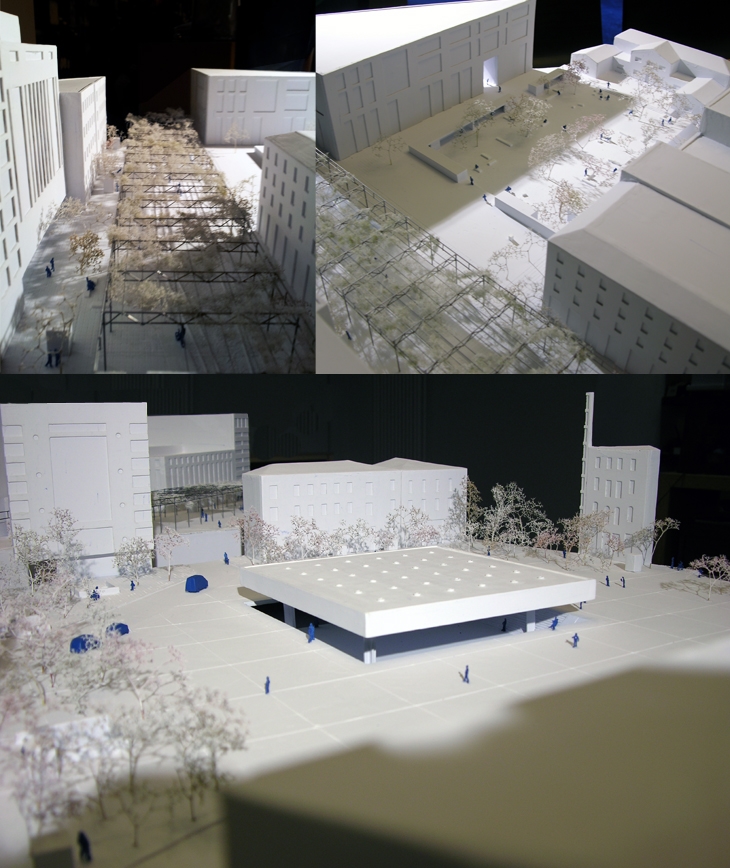 MODELS: PANEPISTIMIOU STREET, DIKAIOSYNIS AND OMONOIA SQUARE.
MODELS: PANEPISTIMIOU STREET, DIKAIOSYNIS AND OMONOIA SQUARE.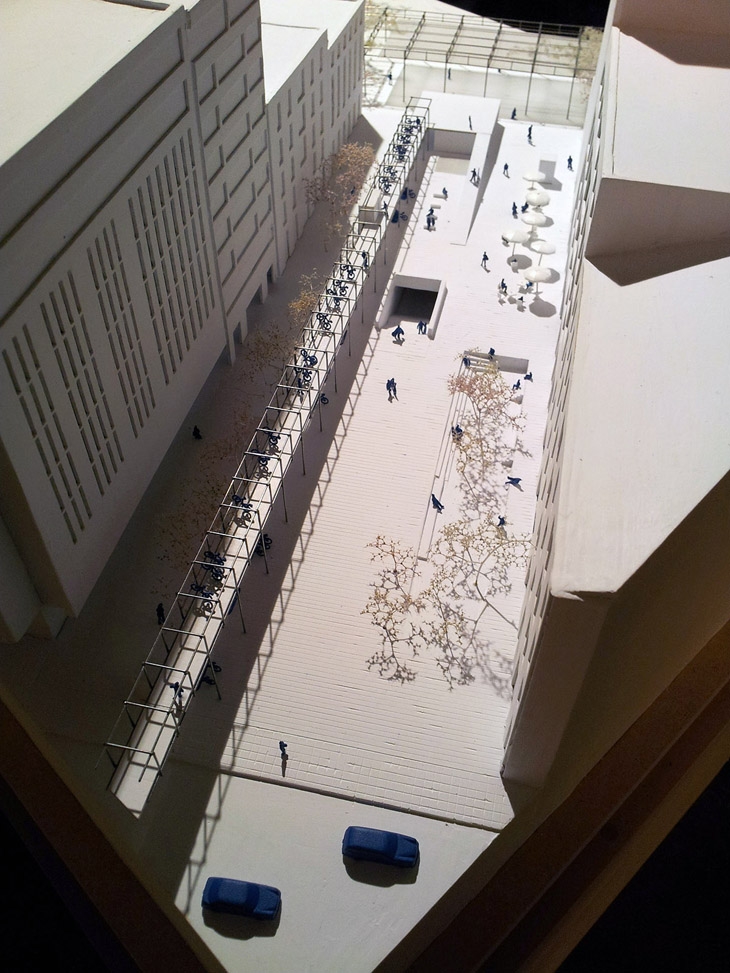 MODEL: VIEW OF THE ?BIKE-ALLEY? CONNECTING KLAFTHMONOS SQUARE WITH PANEPISTIMIOU STREET
MODEL: VIEW OF THE ?BIKE-ALLEY? CONNECTING KLAFTHMONOS SQUARE WITH PANEPISTIMIOU STREET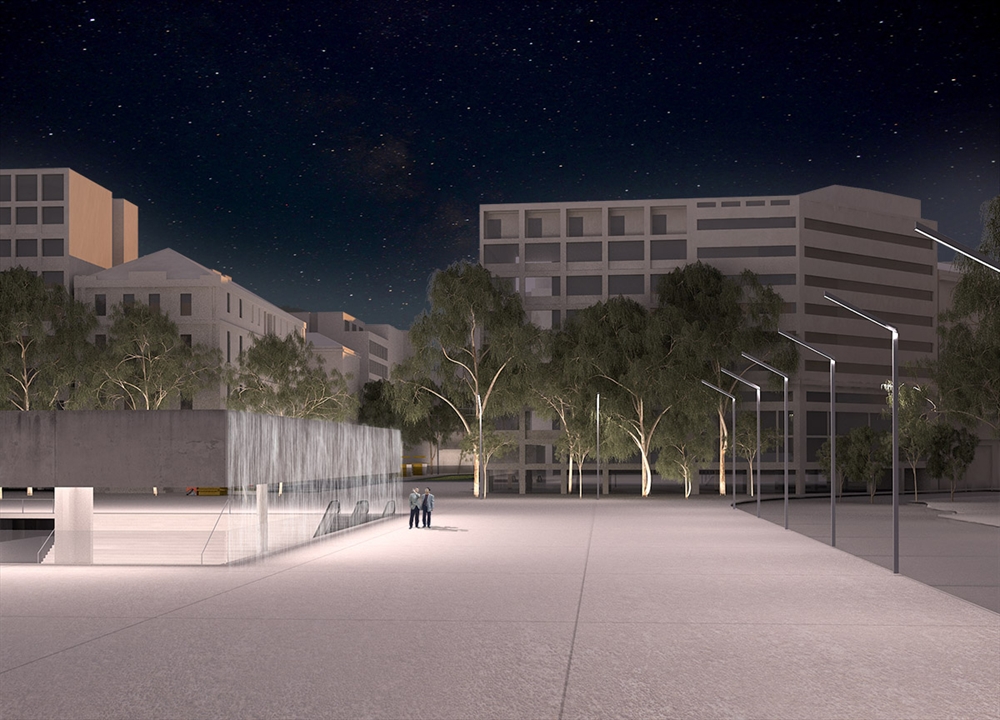 VIEW OF OMONOIA SQUARE DURING THE NIGHT
VIEW OF OMONOIA SQUARE DURING THE NIGHT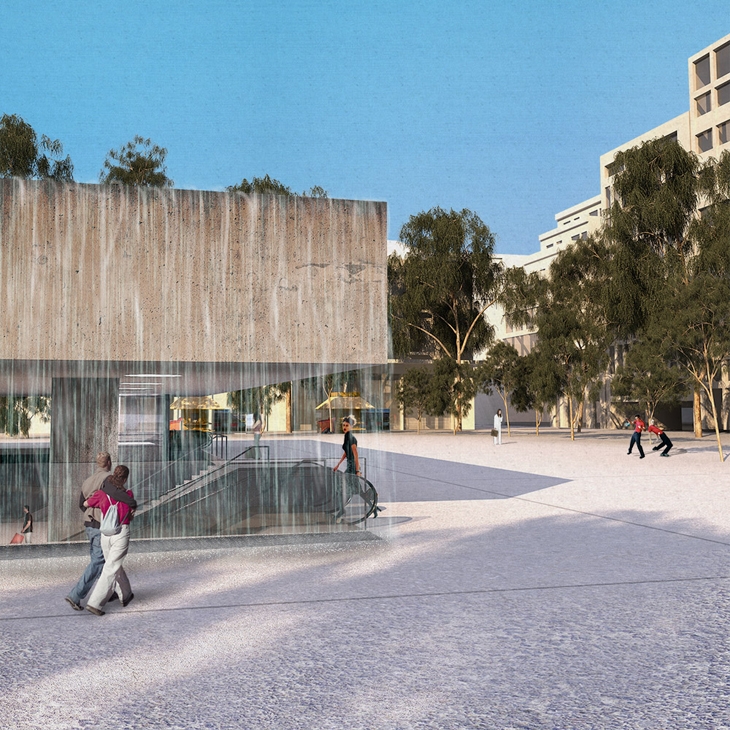 A COOL BREEZE EMANATING FROM OMONOIA?S METRO STATION WATER CURTAIN, OFFERS RELIEF TO THE CROSSING OF THE SQUARE?S PLATEAU ON A HOT SUMMER DAY
A COOL BREEZE EMANATING FROM OMONOIA?S METRO STATION WATER CURTAIN, OFFERS RELIEF TO THE CROSSING OF THE SQUARE?S PLATEAU ON A HOT SUMMER DAY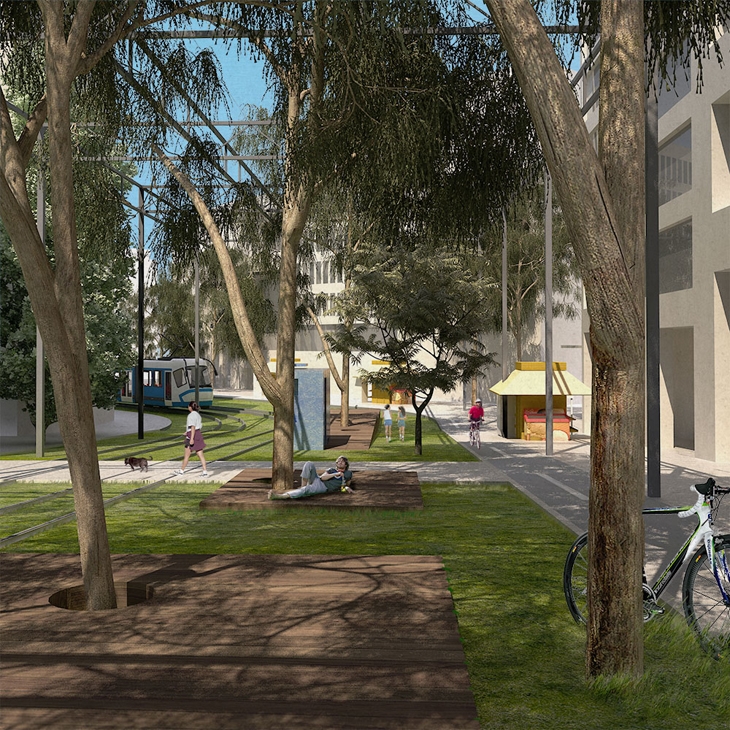 RECREATION TIME UNDER THE GREEN SHADING ?FOREST? CANOPY NEAR PANEPISTIMIOU?S INTERSECTION WITH OMONOIA SQUARE
RECREATION TIME UNDER THE GREEN SHADING ?FOREST? CANOPY NEAR PANEPISTIMIOU?S INTERSECTION WITH OMONOIA SQUARE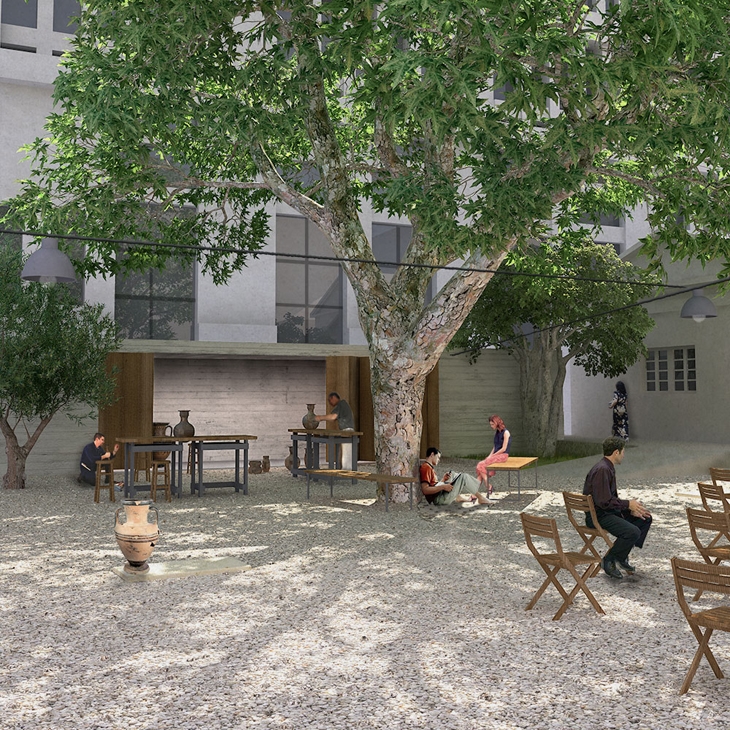 ARTS AND CRAFTS EXPLORED IN THE COOL SHADE OF DIKAIOSYNIS WORKSHOP COURTYARD ON A HOT SUMMER NOON
ARTS AND CRAFTS EXPLORED IN THE COOL SHADE OF DIKAIOSYNIS WORKSHOP COURTYARD ON A HOT SUMMER NOON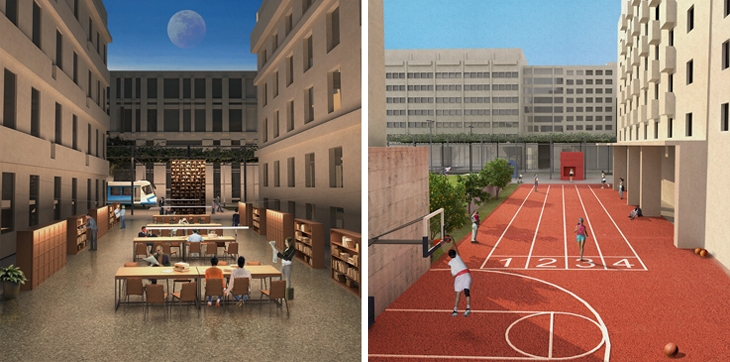 A STRIP SITE OF ATHLETIC ACTIVITIES OFFERING A CHANCE FOR SOME EVENING MUSCLE FLEXING ON ASKLIPIOU STREET / SMALL URBAN ?BOOK LOCKERS? COMBINED WITH READING DESKS SPRAWLING AROUND A BOOK NURSERY (IN FRONT OF THE ?STOA TOU VIVLIOU? ARCADE), FORM THE BACKBONE OF THE ?BOOK CROSSING? EXCHANGE MOVEMENT
A STRIP SITE OF ATHLETIC ACTIVITIES OFFERING A CHANCE FOR SOME EVENING MUSCLE FLEXING ON ASKLIPIOU STREET / SMALL URBAN ?BOOK LOCKERS? COMBINED WITH READING DESKS SPRAWLING AROUND A BOOK NURSERY (IN FRONT OF THE ?STOA TOU VIVLIOU? ARCADE), FORM THE BACKBONE OF THE ?BOOK CROSSING? EXCHANGE MOVEMENT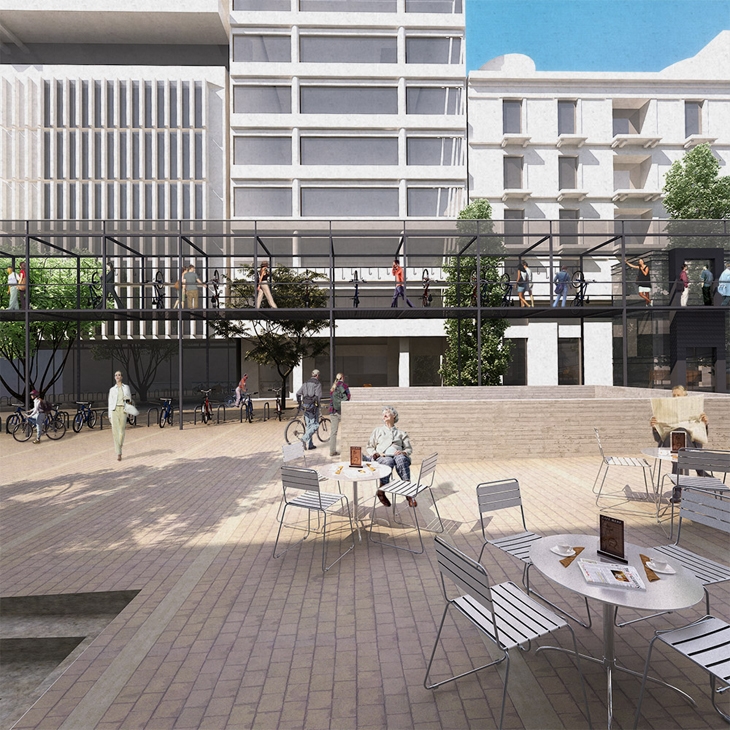 A TYPICAL NOONDAY ALONG THE ?BIKE-ALLEY? CROSSING KORAI WALKWAY
A TYPICAL NOONDAY ALONG THE ?BIKE-ALLEY? CROSSING KORAI WALKWAY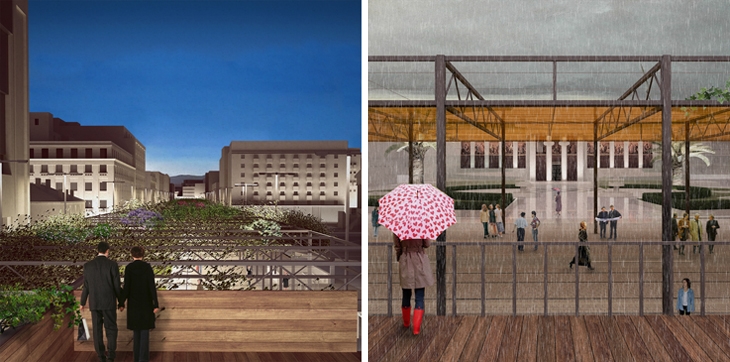 ENJOYING A DUSKY OUTLOOK ON A SEA OF GREEN FROM A WOODEN TERRACE / FINDING RAIN SHELTER UNDER A GLASS ROOF IN FRONT OF THE TRILOGY COMPLEX
ENJOYING A DUSKY OUTLOOK ON A SEA OF GREEN FROM A WOODEN TERRACE / FINDING RAIN SHELTER UNDER A GLASS ROOF IN FRONT OF THE TRILOGY COMPLEX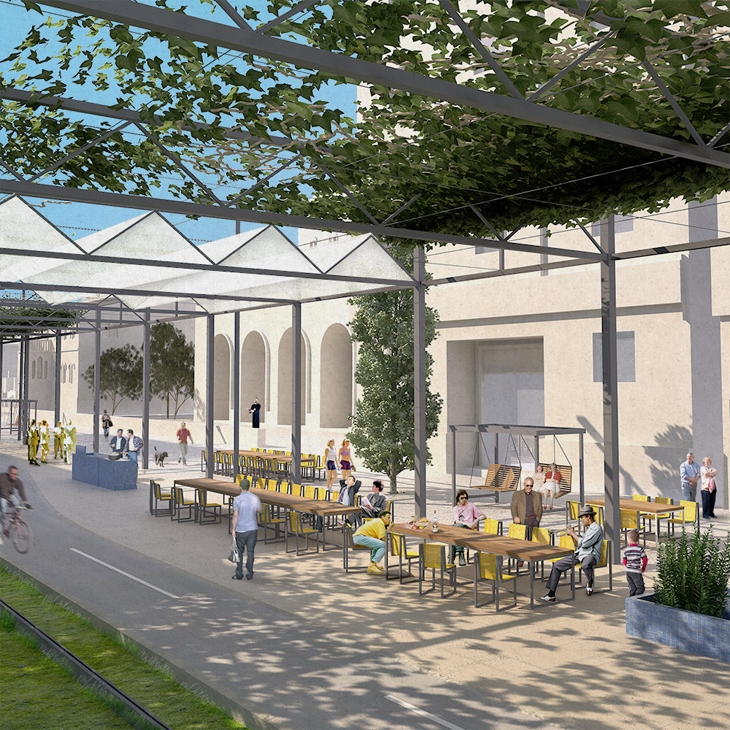 HAVING LUNCH AFTER A MASS, OUTSIDE AGIOS DIONYSIOS CATHOLIC CHURCH ON PANEPISTIMIOU STREET
HAVING LUNCH AFTER A MASS, OUTSIDE AGIOS DIONYSIOS CATHOLIC CHURCH ON PANEPISTIMIOU STREET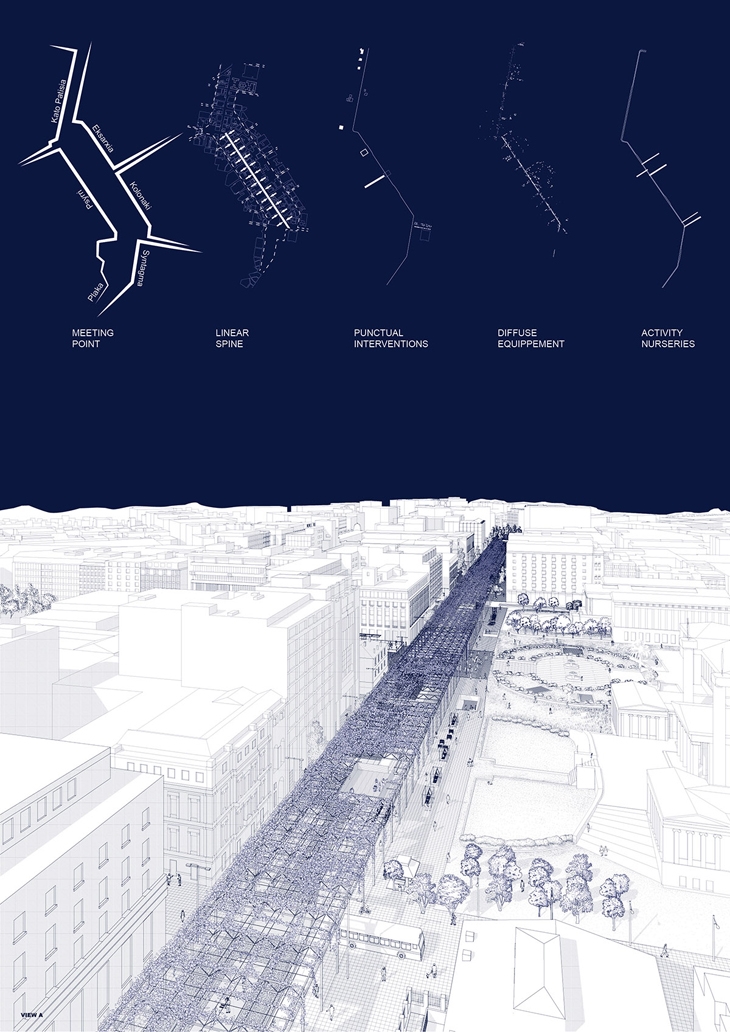 2 PANEPISTIMIOU STREET- CHANGING THE ROAD INTO A PEDESTRIAN AREA DOES NOT NECESSARILY CREATE A LOCUS. TAKING ADVANTAGE OF THE PLANNED TRAM LINE WE CONCENTRATE THE EFFORT ALONG THE INFRASTRUCTURE IN ORDER TO CREATE THE CRITICAL MASS FOR A LOCUS TO BE FORMED. THE POTENTIAL THAT EXTENSIVE INFRASTRUCTURE CARRIES ALONG CAN BE USED TO STIMULATE IMPROMPTU INITIATIVES.
2 PANEPISTIMIOU STREET- CHANGING THE ROAD INTO A PEDESTRIAN AREA DOES NOT NECESSARILY CREATE A LOCUS. TAKING ADVANTAGE OF THE PLANNED TRAM LINE WE CONCENTRATE THE EFFORT ALONG THE INFRASTRUCTURE IN ORDER TO CREATE THE CRITICAL MASS FOR A LOCUS TO BE FORMED. THE POTENTIAL THAT EXTENSIVE INFRASTRUCTURE CARRIES ALONG CAN BE USED TO STIMULATE IMPROMPTU INITIATIVES. 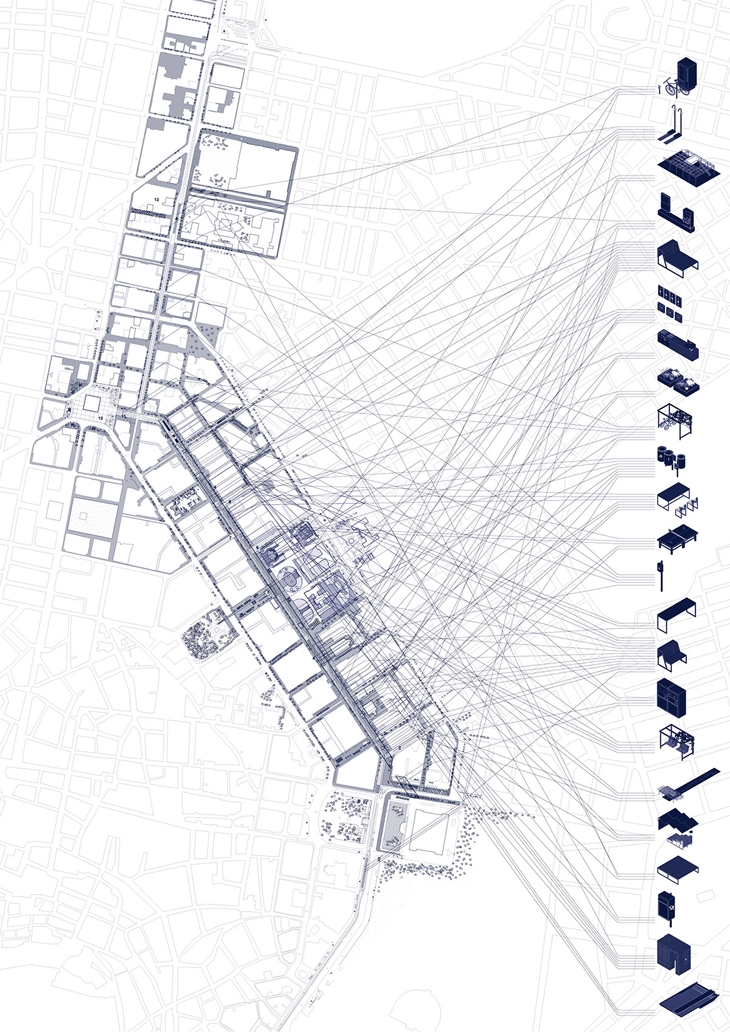 THE PERCEIVED FORM OF THE CITY IS SHAPED BY THE DAILY, INDIVIDUAL ACTIONS OF ITS INHABITANTS. TO PROVIDE A SPATIAL FRAMEWORK WHICH ENCOURAGES AND TRIGGERS CREATIVE INITIATIVES IS AN INVESTMENT TO THE INHABITANTS EXPECTED APPROPRIATION OF THEIR URBAN ENVIRONMENT. THE PROPOSED INFRASTRUCTURE ALONG WITH A VARIETY OF EVERYDAY APPLICATION MODULES SERVES AS A MATRIX TO FOSTER SPONTANEOUS EVENTS IN THE SURROUNDING CITY FIELD. THROUGH SMALL SCALE FACILITIES PEOPLE REGAIN THEIR RIGHT TO RETHINK ATHENS.
THE PERCEIVED FORM OF THE CITY IS SHAPED BY THE DAILY, INDIVIDUAL ACTIONS OF ITS INHABITANTS. TO PROVIDE A SPATIAL FRAMEWORK WHICH ENCOURAGES AND TRIGGERS CREATIVE INITIATIVES IS AN INVESTMENT TO THE INHABITANTS EXPECTED APPROPRIATION OF THEIR URBAN ENVIRONMENT. THE PROPOSED INFRASTRUCTURE ALONG WITH A VARIETY OF EVERYDAY APPLICATION MODULES SERVES AS A MATRIX TO FOSTER SPONTANEOUS EVENTS IN THE SURROUNDING CITY FIELD. THROUGH SMALL SCALE FACILITIES PEOPLE REGAIN THEIR RIGHT TO RETHINK ATHENS. 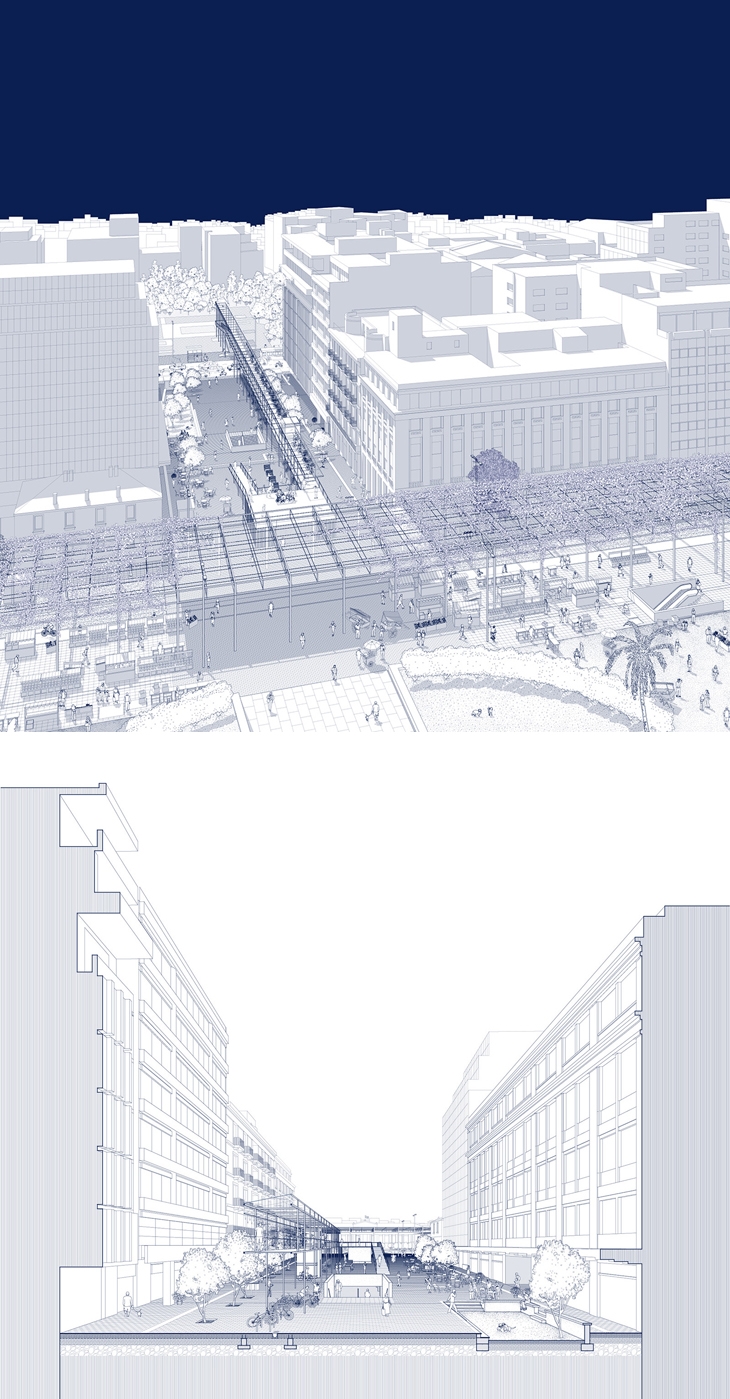 KORAI AND PANEPISTIMIOU STREET- KORAI, DUE TO ITS POSITION AMONG TWO MAJOR CITY NODES (TRILOGY COMPLEX AND KLAFTHMONOS SQR.), IS BOUND TO PLAY A PIVOTAL ROLE. BY INTRODUCING A LINKING ELEMENT IN THE FORM OF A LIGHT METAL PASSAGEWAY HOUSING A BIKE PARKING, KORAI EMERGES AS A PIECE OF CONNECTIVE TISSUE BETWEEN TWO MAIN URBAN ORGANS ENABLING THEM TO ACT IN UNISON. THE INCREASING USE OF THE BICYCLE AS A TRANSPORTATION MEANS REINFORCES THE HUB LIKE CHARACTER OF THIS WALKWAY.
KORAI AND PANEPISTIMIOU STREET- KORAI, DUE TO ITS POSITION AMONG TWO MAJOR CITY NODES (TRILOGY COMPLEX AND KLAFTHMONOS SQR.), IS BOUND TO PLAY A PIVOTAL ROLE. BY INTRODUCING A LINKING ELEMENT IN THE FORM OF A LIGHT METAL PASSAGEWAY HOUSING A BIKE PARKING, KORAI EMERGES AS A PIECE OF CONNECTIVE TISSUE BETWEEN TWO MAIN URBAN ORGANS ENABLING THEM TO ACT IN UNISON. THE INCREASING USE OF THE BICYCLE AS A TRANSPORTATION MEANS REINFORCES THE HUB LIKE CHARACTER OF THIS WALKWAY.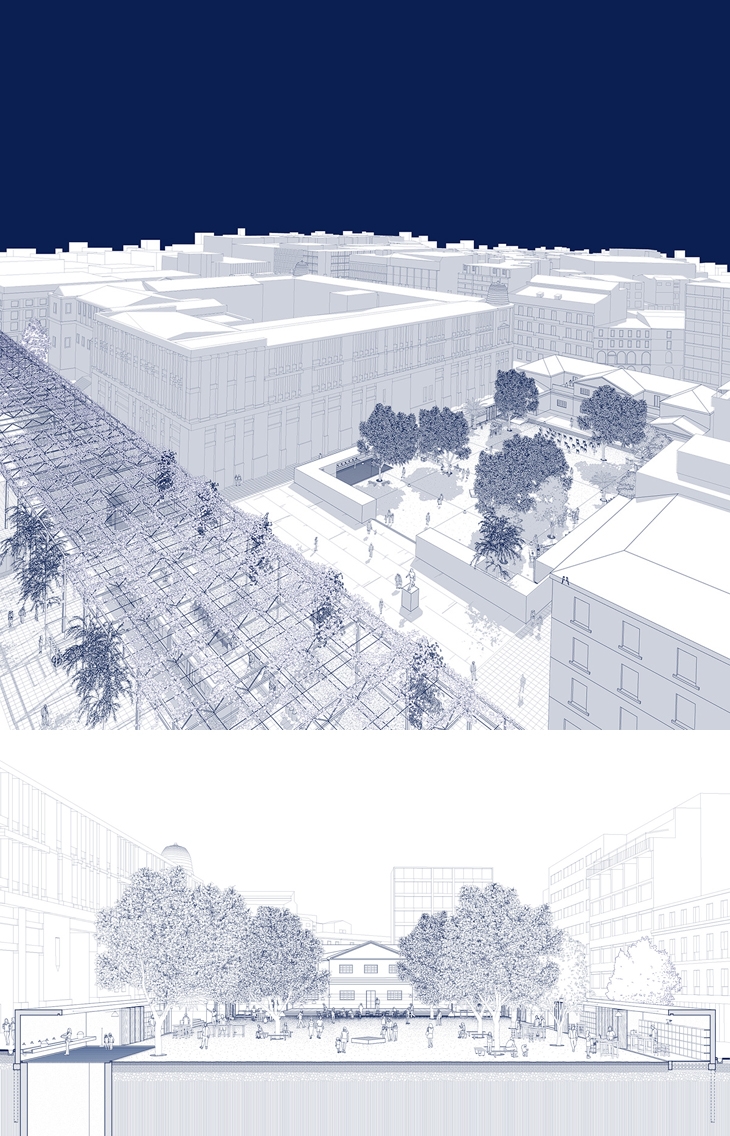 DIKAIOSYNIS SQUARE- A SPACE FORMERLY PERCEIVED AS BLAND AND DISPERSED WHERE NOBODY WOULD ENTER IS BEING WALLED TO TRIGGER PEOPLE?S CURIOSITY. ONCE INSIDE, THE WALL CONTAINS FACILITIES FOR SMALL ART AND CRAFT WORKSHOPS THAT PROVIDE AN OUTLET FOR CREATIVE VENTURES. A NEW KIND OF ACTIVE APPROPRIATION OF URBAN SPACE IS THUS ENABLED, WITH A MULTITUDE OF CRAFTSMANSHIP ITEMS CREATED, REINSERTING THE SMALL SCALE MANUFACTURE IN THE INHABITANTS? EXPERIENCE.
DIKAIOSYNIS SQUARE- A SPACE FORMERLY PERCEIVED AS BLAND AND DISPERSED WHERE NOBODY WOULD ENTER IS BEING WALLED TO TRIGGER PEOPLE?S CURIOSITY. ONCE INSIDE, THE WALL CONTAINS FACILITIES FOR SMALL ART AND CRAFT WORKSHOPS THAT PROVIDE AN OUTLET FOR CREATIVE VENTURES. A NEW KIND OF ACTIVE APPROPRIATION OF URBAN SPACE IS THUS ENABLED, WITH A MULTITUDE OF CRAFTSMANSHIP ITEMS CREATED, REINSERTING THE SMALL SCALE MANUFACTURE IN THE INHABITANTS? EXPERIENCE.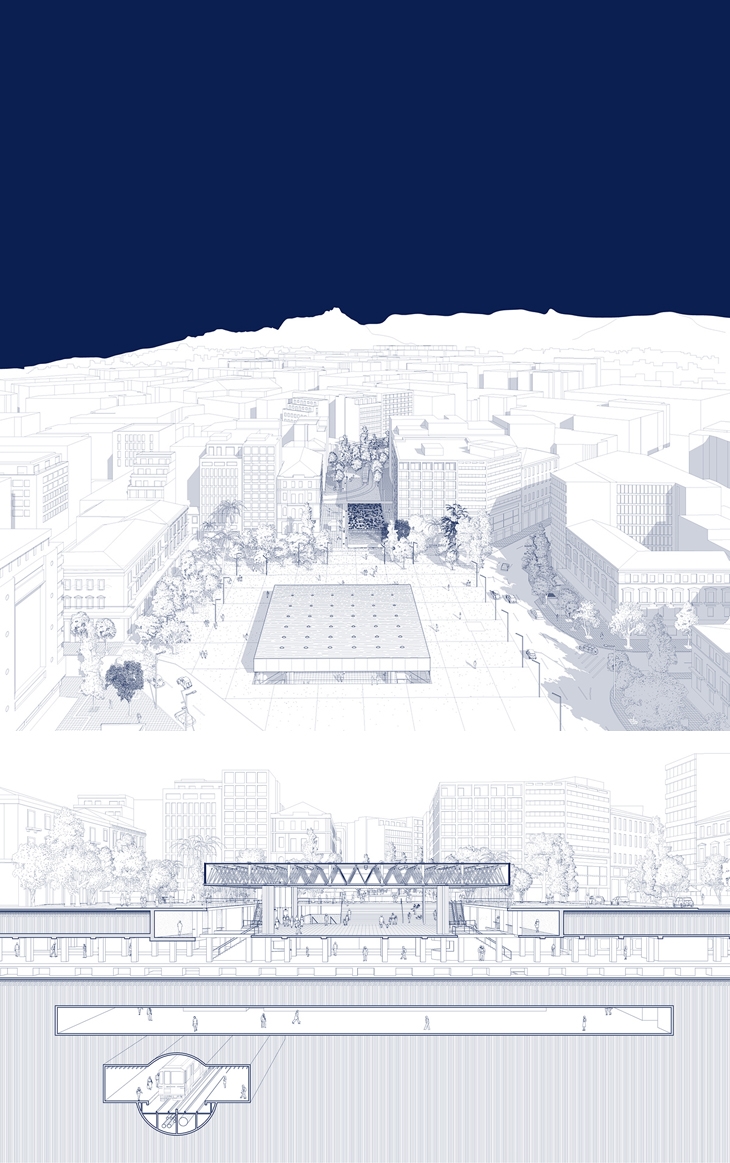 OMONOIA SQUARE- THE FLUX OF PEOPLE, ON THE SQUARE?S GROUND LEVEL WAS UNTIL NOW LIMITED TO THE PERIMETER, WHEREAS THE REAL HUSTLE AND BUSTLE WAS TAKING PLACE IN THE UNDERGROUND CENTER OF THE STATION. TO BRING THIS ACTIVITY TO LIGHT, A CRATER IS FORMED BY LIFTING THE SQUARE ROOF- LID OFF THE GROUND, THUS IMBUING OMONOIA SQUARE WITH A LONG LOST CENTRIPETAL DYNAMIC.
OMONOIA SQUARE- THE FLUX OF PEOPLE, ON THE SQUARE?S GROUND LEVEL WAS UNTIL NOW LIMITED TO THE PERIMETER, WHEREAS THE REAL HUSTLE AND BUSTLE WAS TAKING PLACE IN THE UNDERGROUND CENTER OF THE STATION. TO BRING THIS ACTIVITY TO LIGHT, A CRATER IS FORMED BY LIFTING THE SQUARE ROOF- LID OFF THE GROUND, THUS IMBUING OMONOIA SQUARE WITH A LONG LOST CENTRIPETAL DYNAMIC. READ ALSO: LANDMARK ON THE CENTRAL MALL AT FALIRO BAY, ATTICA ABSTRACT